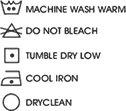 Fabric Options
Fabric Options
 FAQs
FAQs
 Easy Solutions
Easy Solutions
For 30 years, we have provided a quality product, while maintaining an excellent
customer service relationship with our customers.
Each of our labels is crafted with pride in the U.S.A.

Label Service, Inc.
406 W. 32 Street
Charlotte, NC 28206
(704) 377-4800
Fax: (704) 372-0964
|
|
Frequently Asked Questions
| What are the different
finishing options available?
|
Single Cut -- Labels are cut separately with a "cold" knife.
Works with coated materials such as Tyvek, Remay, and Coated Polyester.
Single Hot Cut -- Labels are cut separately with
a "hot" knife. This slightly melts the edges of the fabric, which
prevents fraying. This method is used for Polyester Taffeta and Satins.
Loop Fold -- Labels are folded in the middle. Nice quality look.
End Fold -- Just like it sounds. The left and
right edges of the label are folded, which provides superior holding in the
garment.
On Rolls -- For sewing systems.
|
|
| What color inks
and foils are available?
|
|
A huge selection of colors are available. On most types of labels, we can print multiple colors on the same label. Please contact us for more information.
|
|
| How do I place
an order online?
|
First of all, you will need to decide on some basic information about your
label, that will be entered into our order form. For example, we will ask you
for your label's size, layout, and miscellaneous instructions such as size
changes.
It may be easier to first sketch this out on a piece of paper, and then
go to the order form.
|
|
| What is the
basic anatomy of a label?
|
Your label will possess some or all of these important attributes:
- The Height of a label is its size from top to bottom.
- The Width of a label is its size form left to right.
- The Sew Space or Sew-In Margin is an area at the top of the
label that is left blank, where the label will be attached to the garment.
In Loop Fold finishing, a sew space is utilized
on the top and bottom of the label.
- The Fabric Type is the actual material of which the label is
made, such as Polyester Satin, or Coated Polyester.
- The Fabric Color is the color of the Fabric Type. Certain Fabric
Colors and Ink Colors are not compatible, such as White Fabric with
White Ink.
- The Ink or Foil Colors are the colors used to print your label's
content onto the fabric. Some printing methods allow for multiple colors
on the same label, while others allow for only one.
- The Logo is a custom picture or image that is placed on the
label.
- Standard Care Symbols are a set of symbols the ASTM designated
for depicting care instructions on washable materials. These are often
desired on a care label to supplement text instructions.
For Example: 
|
|
| What precautions
are taken to protect customer data during the online ordering process?
|
Our site uses a secure certificate to encrypt and protect sensitive data
transmitted over the Internet during online purchases. This certificate also
validates our identity to you, and guarantees that no information exchanged
will be intercepted or fraudulently impersonated. Some common questions about
this technology are answered below.
- What is encryption technology?
Encryption is the transformation of text or data into a coded form that
is close to impossible to read without the key to decode the message. This
scrambling of the message is done by using a mathematical formula making
the message appear to be nonsense.
- What are common uses for encryption?
Besides e-commerce applications (such as transmission of credit card numbers,
account numbers, and other sensitive information), encryption is also used
by the military to guard secrets and pay-per-view television channels to
only grant access to paying customers.
- How does encryption work?
In the most basic terms, the sender encodes the message using a mathematical
formula, which scrambles the message, then sends it. The recipient of the
message must then decode the message before it can be read using a special
'key'.
- How secure is encryption?
The level of security of encryption is measured in terms of key length.
The longer the key, the longer it would take someone without the correct
"decoder" to unscramble the code. This key length is measured in bits (e.g.,
40-bit encryption, the level of encryption used with many ordinary browsers,
as opposed to 128-bit encryption, the level of encryption required by eBusiness
IDs). For a 40-bit key there exists 240 possible different key combinations.
Similarly, for a 128-bit key (the level used by Equifax Secure) there are
2128 possible different key combinations. According to Netscape, 128-bit
encryption is 309,485,009,821,345,068,724,781,056 times more powerful than
40-bit encryption.
|
|
|